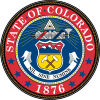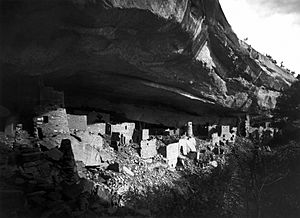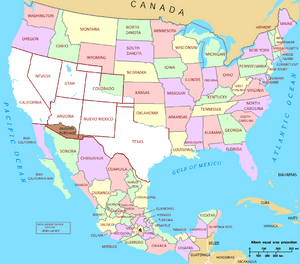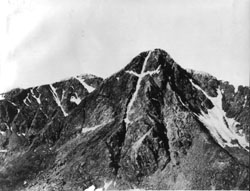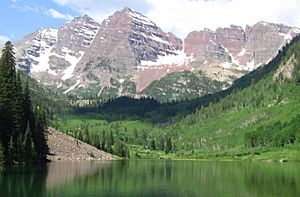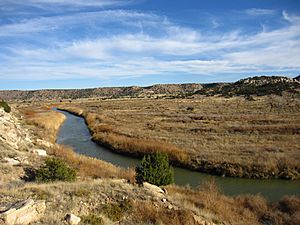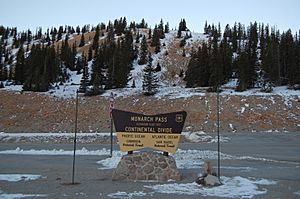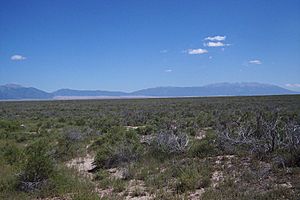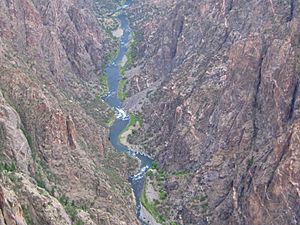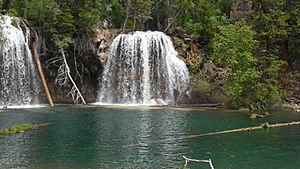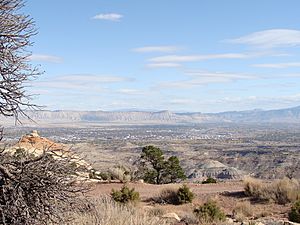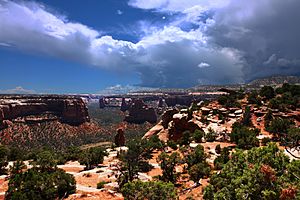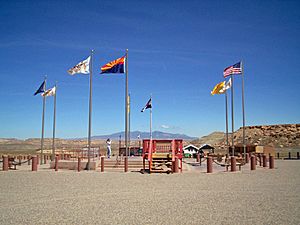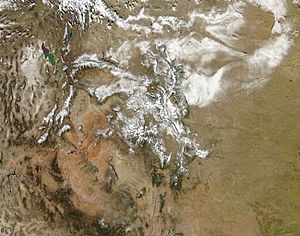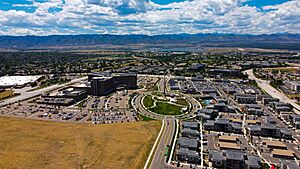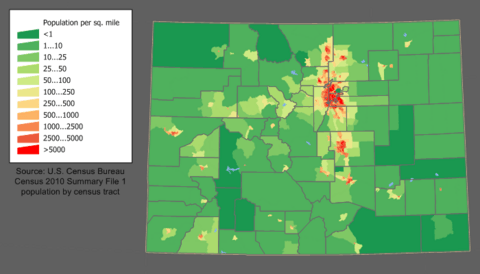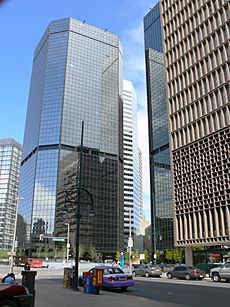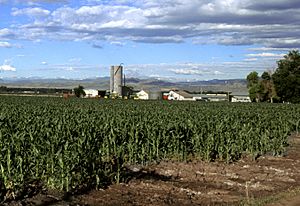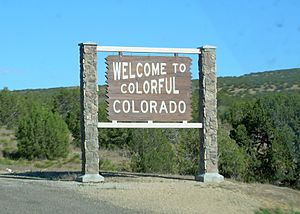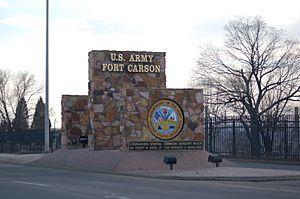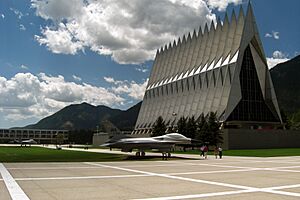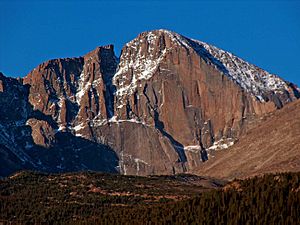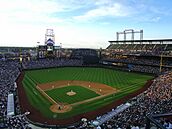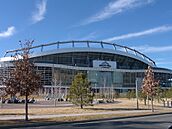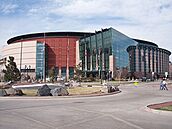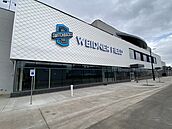Colorado facts for kids
Quick facts for kids
Colorado
|
|||||||||||||||||||
|---|---|---|---|---|---|---|---|---|---|---|---|---|---|---|---|---|---|---|---|
|
|||||||||||||||||||
| Nickname(s): | |||||||||||||||||||
| Motto(s):
Nil sine numine
(English: Nothing without providence) |
|||||||||||||||||||
| Anthem: Where the Columbines Grow and Rocky Mountain High |
|||||||||||||||||||
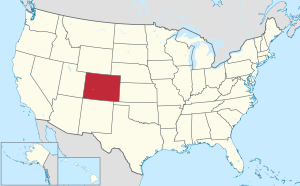
Location of Colorado within the United States
|
|||||||||||||||||||
| Country | United States | ||||||||||||||||||
| Before statehood | Territory of Colorado | ||||||||||||||||||
| Admitted to the Union | August 1, 1876 (38th) | ||||||||||||||||||
| Capital (and largest city) |
Denver | ||||||||||||||||||
| Largest county or equivalent | El Paso | ||||||||||||||||||
| Largest metro and urban areas | Denver | ||||||||||||||||||
| Legislature | General Assembly | ||||||||||||||||||
| • Upper house | Senate | ||||||||||||||||||
| • Lower house | House of Representatives | ||||||||||||||||||
| Judiciary | Supreme Court (list) | ||||||||||||||||||
| U.S. senators | Michael Bennet (D) John Hickenlooper (D) |
||||||||||||||||||
| U.S. House delegation | 4 Democrats 4 Republicans (list) |
||||||||||||||||||
| Area | |||||||||||||||||||
| • Total | 104,185 sq mi (269,837 km2) | ||||||||||||||||||
| • Land | 103,718 sq mi (268,875 km2) | ||||||||||||||||||
| • Water | 376 sq mi (962 km2) 0.36% | ||||||||||||||||||
| Area rank | 8th | ||||||||||||||||||
| Dimensions | |||||||||||||||||||
| • Length | 280 mi (451 km) | ||||||||||||||||||
| • Width | 380 mi (612 km) | ||||||||||||||||||
| Elevation | 6,800 ft (2,070 m) | ||||||||||||||||||
| Highest elevation | 14,440 ft (4,401.2 m) | ||||||||||||||||||
| Lowest elevation | 3,317 ft (1,011 m) | ||||||||||||||||||
| Population
(2024)
|
|||||||||||||||||||
| • Total | |||||||||||||||||||
| • Rank | 21st | ||||||||||||||||||
| • Density | 56.25/sq mi (21.72/km2) | ||||||||||||||||||
| • Density rank | 37th | ||||||||||||||||||
| • Median household income | $92,900 (2023) | ||||||||||||||||||
| • Income rank | 9th | ||||||||||||||||||
| Demonym(s) | Coloradan | ||||||||||||||||||
| Language | |||||||||||||||||||
| • Official language | English | ||||||||||||||||||
| Time zone | UTC−07:00 (MST) | ||||||||||||||||||
| • Summer (DST) | UTC−06:00 (MDT) | ||||||||||||||||||
| USPS abbreviation |
CO
|
||||||||||||||||||
| ISO 3166 code | US-CO | ||||||||||||||||||
| Latitude | 37°N to 41°N | ||||||||||||||||||
| Longitude | 102.0467°W to 109.0467°W | ||||||||||||||||||
|
|||||||||||||||||||
Colorado (![]() i/ˌkɒləˈrædoʊ, -ˈrɑːdoʊ/ kol-Ə-rad-OH-,_---rah, other variants) is a landlocked state in the Mountain West subregion of the Western United States. Colorado borders Wyoming to the north, Nebraska to the northeast, Kansas to the east, Oklahoma to the southeast, New Mexico to the south, Utah to the west, and meets Arizona to the southwest at the Four Corners. Colorado is noted for its landscape of mountains, forests, high plains, mesas, canyons, plateaus, rivers, and desert lands. Colorado is one of the Mountain States and is often considered to be part of the southwestern United States. The high plains of Colorado may be considered a part of the midwestern United States. It encompasses most of the Southern Rocky Mountains, as well as the northeastern portion of the Colorado Plateau and the western edge of the Great Plains. Colorado is the eighth most extensive and 21st most populous U.S. state. The United States Census Bureau estimated the population of Colorado at 5,877,610 as of July 1, 2023, a 1.80% increase since the 2020 United States census.
i/ˌkɒləˈrædoʊ, -ˈrɑːdoʊ/ kol-Ə-rad-OH-,_---rah, other variants) is a landlocked state in the Mountain West subregion of the Western United States. Colorado borders Wyoming to the north, Nebraska to the northeast, Kansas to the east, Oklahoma to the southeast, New Mexico to the south, Utah to the west, and meets Arizona to the southwest at the Four Corners. Colorado is noted for its landscape of mountains, forests, high plains, mesas, canyons, plateaus, rivers, and desert lands. Colorado is one of the Mountain States and is often considered to be part of the southwestern United States. The high plains of Colorado may be considered a part of the midwestern United States. It encompasses most of the Southern Rocky Mountains, as well as the northeastern portion of the Colorado Plateau and the western edge of the Great Plains. Colorado is the eighth most extensive and 21st most populous U.S. state. The United States Census Bureau estimated the population of Colorado at 5,877,610 as of July 1, 2023, a 1.80% increase since the 2020 United States census.
The region has been inhabited by Native Americans and their ancestors for at least 13,500 years and possibly much longer. The eastern edge of the Rocky Mountains was a major migration route for early peoples who spread throughout the Americas. In 1848, much of the Nuevo México region was annexed to the United States with the Treaty of Guadalupe Hidalgo. The Pike's Peak Gold Rush of 1858–1862 created an influx of settlers. On February 28, 1861, U.S. President James Buchanan signed an act creating the Territory of Colorado, and on August 1, 1876, President Ulysses S. Grant signed Proclamation 230 admitting Colorado to the Union as the 38th state. The Spanish adjective "colorado" means "colored red" or "ruddy". Colorado is nicknamed the "Centennial State" because it became a state one century (and four weeks) after the signing of the United States Declaration of Independence.
Denver is the capital, the most populous city, and the center of the Front Range Urban Corridor. Colorado Springs is the second most populous city of the state. Residents of the state are known as Coloradans, although the antiquated "Coloradoan" is occasionally used. Major parts of the economy include government and defense, mining, agriculture, tourism, and increasingly other kinds of manufacturing. With increasing temperatures and decreasing water availability, Colorado's agriculture, forestry, and tourism economies are expected to be heavily affected by climate change.
Contents
History
The region that is today the state of Colorado has been inhabited by Native Americans for more than 13,000 years.
The U.S. acquired a territorial claim to the eastern Rocky Mountains with the Louisiana Purchase from France in 1803. This U.S. claim conflicted with the claim by Spain to the upper Arkansas River Basin as the exclusive trading zone of its colony of Santa Fé de Nuevo Méjico. In 1806, Zebulon Pike led a U.S. Army reconnaissance expedition into the disputed region. Colonel Pike and his men were arrested by Spanish cavalrymen in the San Luis Valley the following February, taken to Chihuahua, and expelled from Mexico the following July.
The U.S. relinquished its claim to all land south and west of the Arkansas River and south of 42nd parallel north and west of the 100th meridian west as part of its purchase of Florida from Spain with the Adams-Onís Treaty of 1819. Mexico eventually ratified the Adams-Onís Treaty in 1831. The Texian Revolt of 1835–36 fomented a dispute between the U.S. and Mexico which eventually erupted into the Mexican–American War in 1846. Mexico surrendered its northern territory to the U.S. with the Treaty of Guadalupe Hidalgo at the conclusion of the war in 1848.
Most American settlers traveling overland west to the Oregon Country, namely the new goldfields of California, or the new Mormon settlements of the State of Deseret in the Salt Lake Valley, avoided the rugged Southern Rocky Mountains.
In 1854, Senator Stephen A. Douglas persuaded the U.S. Congress to divide the unorganized territory east of the Continental Divide into two new organized territories, the Territory of Kansas and the Territory of Nebraska, and an unorganized southern region known as the Indian territory.
The election of Abraham Lincoln for the President of the United States on November 6, 1860, led to the secession of nine southern slave states and the threat of civil war among the states. The Republican Party-dominated Congress and admitted the eastern portion of the Territory of Kansas into the Union as the free State of Kansas on January 29, 1861, leaving the western portion of the Kansas Territory, and its gold-mining areas, as unorganized territory.
Territory act
Thirty days later on February 28, 1861, outgoing U.S. President James Buchanan signed an Act of Congress organizing the free Territory of Colorado.
On April 12, 1861, South Carolina artillery opened fire on Fort Sumter to start the American Civil War.
In 1862, a force of Texas cavalry invaded the Territory of New Mexico and captured Santa Fe on March 10. On March 28, the Coloradans and local New Mexico volunteers stopped the Texans at the Battle of Glorieta Pass and the Texans abandoned Santa Fe and returned to San Antonio in defeat. The Confederacy made no further attempts to seize the Southwestern United States.
In the midst and aftermath of Civil War, many discouraged prospectors returned to their homes, but a few stayed and developed mines, mills, farms, ranches, roads, and towns in Colorado Territory.
Statehood

The United States Congress passed an enabling act on March 3, 1875, specifying the requirements for the Territory of Colorado to become a state. On August 1, 1876 (28 days after the Centennial of the United States), U.S. President Ulysses S. Grant signed a proclamation admitting Colorado to the Union as the 38th state and earning it the moniker "Centennial State".
The discovery of a major silver lode near Leadville in 1878 triggered the Colorado Silver Boom.
Colorado women were granted the right to vote beginning on November 7, 1893, making Colorado the second state to grant universal suffrage and the first one by a popular vote (of Colorado men).
Tourism became a mainstay of the state economy, and high technology became an important economic engine.
Three warships of the U.S. Navy have been named the USS Colorado. The first USS Colorado was named for the Colorado River. The later two ships were named in honor of the state, including the battleship USS Colorado which served in World War II in the Pacific beginning in 1941. At the time of the Attack on Pearl Harbor, this USS Colorado was located at the naval base in San Diego, Calif. and because of that wasn't harmed in the attack.
Geography
Colorado is notable for its diverse geography, ranging from alpine mountains, arid plains and deserts with huge sand dunes, deep canyons, sandstone and granite rock formations, rivers, lakes, and lush forests.
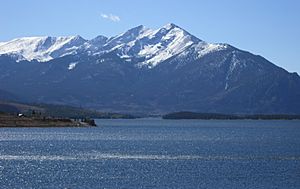
Mountains
The summit of Mount Elbert at 14,440 feet (4,401.2 m) elevation in Lake County is the highest point in Colorado and the Rocky Mountains of North America. Colorado is the only U.S. state that lies entirely above 1,000 meters elevation. The point where the Arikaree River flows out of Yuma County, Colorado, and into Cheyenne County, Kansas, is the lowest point in Colorado at 3,317 feet (1,011 m) elevation. This point, which holds the distinction of being the highest low elevation point of any state, is higher than the high elevation points of 18 states and the District of Columbia.
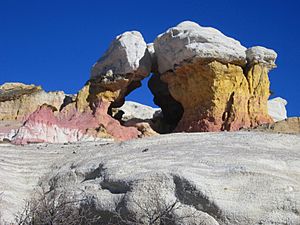
Plains
A little less than one half of the area of Colorado is flat and rolling land. Corn, wheat, hay, soybeans, and oats are all typical crops, and most of the villages and towns in this region boast both a water tower and a grain elevator. Irrigation water is available from the South Platte, the Arkansas River, and a few other streams, and also from subterranean sources, including artesian wells. As well as crop agriculture, eastern Colorado hosts considerable livestock, such as cattle ranches and hog farms.
Front range
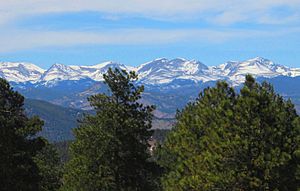
Roughly 70% of Colorado's population resides along the eastern edge of the Rocky Mountains in the Front Range Urban Corridor between Cheyenne, Wyoming, and Pueblo, Colorado. This region is partially protected from prevailing storms that blow in from the Pacific Ocean region by the high Rockies in the middle of Colorado. The "Front Range" includes Denver, Boulder, Fort Collins, Loveland, Colorado Springs, Pueblo, Greeley and other townships and municipalities in between. On the other side of the Rockies, the significant population centers in Western Colorado (which is not considered the "Front Range") are the cities of Grand Junction, Durango, and Montrose.
Continental Divide
The Continental Divide of the Americas extends along the crest of the Rocky Mountains. The area of Colorado to the west of the Continental Divide is called the Western Slope of Colorado. Drainage water west of the Continental Divide flows to the southwest via the Colorado River and the Green River into the Gulf of California.
Within the interior of the Rocky Mountains are several large parks which are high broad basins.
Southern region
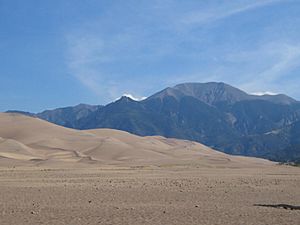
In southmost Colorado is the large San Luis Valley, where the headwaters of the Rio Grande are located.
Peaks
To the west of the Great Plains of Colorado rises the eastern slope of the Rocky Mountains. Notable peaks of the Rocky Mountains include Longs Peak, Mount Evans, Pikes Peak, and the Spanish Peaks near Walsenburg, in southern Colorado. This area drains to the east and the southeast, ultimately either via the Mississippi River or the Rio Grande into the Gulf of Mexico.
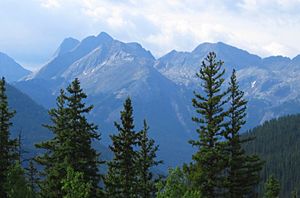
The Rocky Mountains within Colorado contain about 53 peaks that are 14,000 feet (4,267 m) or higher in elevation above sea level, known as fourteeners. These mountains are largely covered with trees such as conifers and aspens up to the tree line, at an elevation of about 12,000 feet (3,700 m)* in southern Colorado to about 10,500 feet (3,200 m) in northern Colorado. Above this only alpine vegetation grows. Only small parts of the Colorado Rockies are snow-covered year round.
Much of the alpine snow melts by mid-August with the exception of a few snowcapped peaks and a few small glaciers. The Colorado Mineral Belt, stretching from the San Juan Mountains in the southwest to Boulder and Central City on the front range, contains most of the historic gold- and silver-mining districts of Colorado. Mount Elbert is the highest summit of the Rocky Mountains. The 30 highest major summits of the Rocky Mountains of North America all lie within the state.

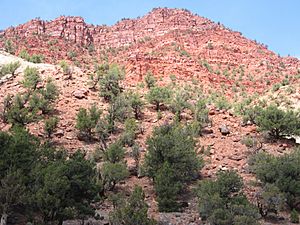
Colorado Western Slope
The Western Slope of Colorado is drained by the Colorado River and its tributaries (primarily the Gunnison River, Green River and the San Juan River) or by evaporation in its arid areas.
The city of Grand Junction, Colorado is the largest city on the Western Slope.
The Western Slope lies in close proximity to multiple notable destinations in the Colorado Rocky Mountains, including Glenwood Springs, with its resort hot springs, and the ski resorts of Aspen, Breckenridge, Vail, Crested Butte, Steamboat Springs, and Telluride.
The northwestern corner of Colorado is a sparsely populated region, and it contains part of the noted Dinosaur National Monument, which is not only a paleontological area, but is also a scenic area of rocky hills, canyons, arid desert, and streambeds. Here, the Green River briefly crosses over into Colorado.
From west to east, the land of Colorado consists of desert lands, desert plateaus, alpine mountains, National Forests, relatively flat grasslands, scattered forests, buttes, and canyons in the western edge of the Great Plains. The famous Pikes Peak is located just west of Colorado Springs. Its isolated peak is visible from nearly the Kansas border on clear days, and also far to the north and the south.
Desert lands in Colorado are located in and around areas such as the Pueblo, Canon City, Florence, Great Sand Dunes National Park and Preserve, San Luis Valley, Cortez, Canyon of the Ancients National Monument, Hovenweep National Monument, Ute Mountain, Delta, Grand Junction, Colorado National Monument, and other areas surrounding the Uncompahgre Plateau and Uncompahgre National Forest.
Colorado is one of four states in the United States that share a common geographic point - the Four Corners together with Arizona, New Mexico, and Utah. At this intersection, it is possible to stand in four states at once.
Climate
The climate of Colorado is more complex than states outside of the Mountain States region. Unlike most other states, southern Colorado is not always warmer than northern Colorado. Most of Colorado is made up of mountains, foothills, high plains, and desert lands. Mountains and surrounding valleys greatly affect local climate.
Northeast, east, and southeast Colorado are mostly the high plains, while Northern Colorado is a mix of high plains, foothills, and mountains. Northwest and west Colorado are predominantly mountainous, with some desert lands mixed in. Southwest and southern Colorado are a complex mixture of desert and mountain areas.
Eastern Plains

The climate of the Eastern Plains is a semi-arid climate. The area is known for its abundant sunshine and cool, clear nights, which give this area a great average diurnal temperature range. The difference between the highs of the days and the lows of the nights can be considerable as warmth dissipates to space during clear nights, the heat radiation not being trapped by clouds.
The Front Range urban corridor, where most of the population of Colorado resides, lies in a pronounced precipitation shadow as a result of being on the lee side of the Rocky Mountains.
In summer, this area can have many days above 95 °F (35 °C) and often 100 °F (38 °C). On the plains, the winter lows usually range from 25 to −10 °F (−4 to −23 °C). About 75% of the precipitation falls within the growing season, from April to September, but this area is very prone to droughts. Most of the precipitation comes from thunderstorms, which can be severe, and from major snowstorms that occur in the winter and early spring. Otherwise, winters tend to be mostly dry and cold.
In much of the region, March is the snowiest month. April and May are normally the rainiest months, while April is the wettest month overall.
Front range foothills
Just west of the plains and into the foothills, there are a wide variety of climate types. Locations merely a few miles apart can experience entirely different weather depending on the topography. Most valleys have a semi-arid climate, which transitions to an alpine climate at higher elevations. There are also pockets of subtropical highland and humid subtropical climates.
Extreme weather
Extreme weather changes are common in Colorado, although the majority of extreme weather occurs in the least populated areas of the state. Thunderstorms are common east of the Continental Divide in the spring and summer, yet are usually brief. Hail is a common sight in the mountains east of the divide and in the northwest part of the state. The Eastern Plains have had some of the biggest hail storms in North America.
The Eastern Plains are part of the extreme western portion of Tornado Alley; some damaging tornadoes in the Eastern Plains include the 1990 Limon F3 tornado and the 2008 Windsor EF3 tornado, which devastated the small town. The plains are also susceptible to occasional floods, which are caused both by thunderstorms and by the rapid melting of snow in the mountains during warm weather.
Much of Colorado is a very dry state averaging only 17 in (430 mm) of precipitation per year statewide and rarely experiences a time when some portion of the state is not in some degree of drought. The lack of precipitation contributes to the severity of wildfires in the state.
However, some of the mountainous regions of Colorado receive a huge amount of moisture from winter snowfalls. The spring melts of these snows often cause great waterflows in the Yampa River, the Colorado River, the Rio Grande, the Arkansas River, the North Platte River, and the South Platte River.
Water flowing out of the Colorado Rocky Mountains is a very significant source of water for the farms, towns, and cities of the southwest states of New Mexico, Arizona, Utah, and Nevada, as well as the Midwest, such as Nebraska and Kansas, and the southern states of Oklahoma and Texas. A significant amount of water is also diverted for use in California; occasionally (formerly naturally and consistently), the flow of water reaches northern Mexico.
Fauna

A process of extirpation by trapping and poisoning of the gray wolf (Canis lupus) from Colorado in the 1930s saw the last wild wolf in the state shot in 1945. A wolf pack recolonized Moffat County, Colorado in northwestern Colorado in 2019. Cattle farmers have expressed concern that a returning wolf population potentially threatens their herds. Coloradans voted to reintroduce gray wolves in 2020, with the state committing to a plan to have a population in the state by 2022 and permitting non-lethal methods of driving off wolves attacking livestock and pets.
While there is fossil evidence of Harrington's mountain goat in Colorado between at least 800,000 years ago and its extinction with megafauna roughly 11,000 years ago, the mountain goat is not native to Colorado but was instead introduced to the state over time during the interval between 1947 and 1972. Despite being an artificially-introduced species, the state declared mountain goats a native species in 1993. In 2013, 2014, and 2019, an unknown illness killed nearly all mountain goat kids, leading to a Colorado Parks and Wildlife investigation.
The native population of pronghorn in Colorado has varied wildly over the last century, reaching a low of only 15,000 individuals during the 1960s. However, conservation efforts succeeded in bringing the stable population back up to roughly 66,000 by 2013. The population was estimated to have reached 85,000 by 2019 and had increasingly more run-ins with the increased suburban housing along the eastern Front Range. State wildlife officials suggested that landowners would need to modify fencing to allow the greater number of pronghorns to move unabated through the newly developed land. Pronghorns are most readily found in the northern and eastern portions of the state, with some populations also in the western San Juan Mountains.
Common wildlife found in the mountains of Colorado include mule deer, southwestern red squirrel, golden-mantled ground squirrel, yellow-bellied marmot, moose, American pika, and red fox, all at exceptionally high numbers, though moose are not native to the state. The foothills include deer, fox squirrel, desert cottontail, mountain cottontail, and coyote. The prairies are home to black-tailed prairie dog, the endangered swift fox, American badger, and white-tailed jackrabbit.
Government
State government
Like the federal government and all other U.S. states, Colorado's state constitution provides for three branches of government: the legislative, the executive, and the judicial branches.
The Governor of Colorado heads the state's executive branch. Colorado's other statewide elected executive officers are the Lieutenant Governor of Colorado (elected on a ticket with the Governor), Secretary of State of Colorado, Colorado State Treasurer, and Attorney General of Colorado, all of whom serve four-year terms.
The seven-member Colorado Supreme Court is the state's highest court. The Colorado Court of Appeals, with 22 judges, sits in divisions of three judges each. Colorado is divided into 22 judicial districts, each of which has a district court and a county court with limited jurisdiction. The state also has specialized water courts, which sit in seven distinct divisions around the state and which decide matters relating to water rights and the use and administration of water.
The state legislative body is the Colorado General Assembly, which is made up of two houses – the House of Representatives and the Senate. The House has 65 members and the Senate has 35. As of 2023[update], the Democratic Party holds a 23 to 12 majority in the Senate and a 46 to 19 majority in the House.
Most Coloradans are native to other states (nearly 60% according to the 2000 census), and this is illustrated by the fact that the state did not have a native-born governor from 1975 (when John David Vanderhoof left office) until 2007, when Bill Ritter took office; his election the previous year marked the first electoral victory for a native-born Coloradan in a gubernatorial race since 1958 (Vanderhoof had ascended from the Lieutenant Governorship when John Arthur Love was given a position in Richard Nixon's administration in 1973).
Tax is collected by the Colorado Department of Revenue.
Counties
The State of Colorado is divided into 64 counties. Two of these counties, the City and County of Broomfield and the City and County of Denver, have consolidated city and county governments. Counties are important units of government in Colorado since there are no civil townships or other minor civil divisions.
The most populous county in Colorado is El Paso County, the home of the City of Colorado Springs. The second most populous county is the City and County of Denver, the state capital. Five of the 64 counties now have more than 500,000 residents, while 12 have fewer than 5,000 residents. The ten most populous Colorado counties are all located in the Front Range Urban Corridor. Mesa County is the most populous county on the Colorado Western Slope.
| 2023 rank | County | County seat | Most populous city | 2023 population |
|---|---|---|---|---|
| 1 | El Paso County | Colorado Springs | Colorado Springs | 744,215 |
| 2 | City and County of Denver | Denver | Denver | 716,577 |
| 3 | Arapahoe County | Littleton | Aurora | 656,061 |
| 4 | Jefferson County | Golden | Lakewood | 576,366 |
| 5 | Adams County | Brighton | Thornton | 533,365 |
| 6 | Douglas County | Castle Rock | Highlands Ranch | 383,906 |
| 7 | Larimer County | Fort Collins | Fort Collins | 370,771 |
| 8 | Weld County | Greeley | Greeley | 359,442 |
| 9 | Boulder County | Boulder | Boulder | 326,831 |
| 10 | Pueblo County | Pueblo | Pueblo | 169,422 |
| 11 | Mesa County | Grand Junction | Grand Junction | 159,681 |
| 12 | City and County of Broomfield | Broomfield | Broomfield | 76,860 |
| 13 | Garfield County | Glenwood Springs | Rifle | 62,707 |
| 14 | La Plata County | Durango | Durango | 56,407 |
| 15 | Eagle County | Eagle | Edwards | 54,381 |
| 16 | Fremont County | Cañon City | Cañon City | 50,318 |
Municipalities
Colorado has 272 active incorporated municipalities, comprising 197 towns, 73 cities, and two consolidated city and county governments. At the 2020 United States census, 4,299,942 of the 5,773,714 Colorado residents (74.47%) lived in one of these 272 municipalities. Another 714,417 residents (12.37%) lived in one of the 210 census-designated places, while the remaining 759,355 residents (13.15%) lived in the many rural and mountainous areas of the state.
Colorado municipalities operate under one of five types of municipal governing authority. Colorado currently has two consolidated city and county governments, 61 home rule cities, 12 statutory cities, 35 home rule towns, 161 statutory towns, and one territorial charter municipality.
The most populous municipality is the City and County of Denver. Colorado has 12 municipalities with more than 100,000 residents, and 17 with fewer than 100 residents. The 16 most populous Colorado municipalities are all located in the Front Range Urban Corridor. The City of Grand Junction is the most populous municipality on the Colorado Western Slope. The Town of Carbonate has had no year-round population since the 1890 census due to its severe winter weather and difficult access.
Unincorporated communities
In addition to its 272 municipalities, Colorado has 210 unincorporated census-designated places (CDPs) and many other small communities. The most populous unincorporated community in Colorado is Highlands Ranch south of Denver. The seven most populous CDPs are located in the Front Range Urban Corridor. The Clifton CDP is the most populous CDP on the Colorado Western Slope.
| 2020 rank | Census-designated place | County | 2020 census |
|---|---|---|---|
| 1 | Highlands Ranch CDP | Douglas County | 103,444 |
| 2 | Security-Widefield CDP | El Paso County | 38,639 |
| 3 | Dakota Ridge CDP | Jefferson County | 33,892 |
| 4 | Ken Caryl CDP | Jefferson County | 33,811 |
| 5 | Pueblo West CDP | Pueblo County | 33,086 |
| 6 | Columbine CDP | Jefferson and Arapahoe counties | 25,229 |
| 7 | Four Square Mile CDP | Arapahoe County | 22,872 |
| 8 | Clifton CDP | Mesa County | 20,413 |
| 9 | Cimarron Hills CDP | El Paso County | 19,311 |
| 10 | Sherrelwood CDP | Adams County | 19,228 |
Special districts
Colorado has more than 4,000 special districts, most with property tax authority. These districts may provide schools, law enforcement, fire protection, water, sewage, drainage, irrigation, transportation, recreation, infrastructure, cultural facilities, business support, redevelopment, or other services.
Some of these districts have the authority to levy sales tax as well as property tax and use fees. This has led to a hodgepodge of sales tax and property tax rates in Colorado. There are some street intersections in Colorado with a different sales tax rate on each corner, sometimes substantially different.
Some of the more notable Colorado districts are:
- The Regional Transportation District (RTD), which affects the counties of Denver, Boulder, Jefferson, and portions of Adams, Arapahoe, Broomfield, and Douglas Counties
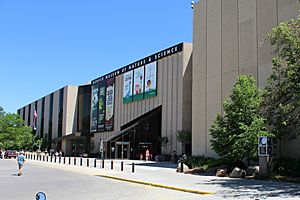
- The Scientific and Cultural Facilities District (SCFD), a special regional tax district with physical boundaries contiguous with county boundaries of Adams, Arapahoe, Boulder, Broomfield, Denver, Douglas, and Jefferson Counties
- It is a 0.1% retail sales and uses tax (one penny on every $10).
- According to the Colorado statute, the SCFD distributes the money to local organizations on an annual basis. These organizations must provide for the enlightenment and entertainment of the public through the production, presentation, exhibition, advancement, or preservation of art, music, theater, dance, zoology, botany, natural history, or cultural history.
- As directed by statute, SCFD recipient organizations are currently divided into three "tiers" among which receipts are allocated by percentage.
- Tier I includes regional organizations: the Denver Art Museum, the Denver Botanic Gardens, the Denver Museum of Nature and Science, the Denver Zoo, and the Denver Center for the Performing Arts. It receives 65.5%.
- Tier II currently includes 26 regional organizations. Tier II receives 21%.
- Tier III has more than 280 local organizations such as small theaters, orchestras, art centers, natural history, cultural history, and community groups. Tier III organizations apply for funding from the county cultural councils via a grant process. This tier receives 13.5%.
- An 11-member board of directors oversees the distributions by the Colorado Revised Statutes. Seven board members are appointed by county commissioners (in Denver, the Denver City Council) and four members are appointed by the Governor of Colorado.
- The Football Stadium District (FD or FTBL), approved by the voters to pay for and help build the Denver Broncos' stadium Empower Field at Mile High.
- Local Improvement Districts (LID) within designated areas of Jefferson and Broomfield counties.
- The Metropolitan Major League Baseball Stadium District, approved by voters to pay for and help build the Colorado Rockies' stadium Coors Field.
- Regional Transportation Authority (RTA) taxes at varying rates in Basalt, Carbondale, Glenwood Springs, and Gunnison County.
Statistical areas
Most recently on March 6, 2020, the Office of Management and Budget defined 21 statistical areas for Colorado comprising four combined statistical areas, seven metropolitan statistical areas, and ten micropolitan statistical areas.
The most populous of the seven metropolitan statistical areas in Colorado is the 10-county Denver-Aurora-Lakewood, CO Metropolitan Statistical Area with a population of 2,963,821 at the 2020 United States census, an increase of +15.29% since the 2010 census.
The more extensive 12-county Denver-Aurora, CO Combined Statistical Area had a population of 3,623,560 at the 2020 census, an increase of +17.23% since the 2010 census.
The most populous extended metropolitan region in Rocky Mountain Region is the 18-county Front Range Urban Corridor along the northeast face of the Southern Rocky Mountains. This region with Denver at its center had a population of 5,055,344 at the 2020 census, an increase of +16.65% since the 2010 census.
Demographics
The United States Census Bureau estimated the population of Colorado on July 1, 2023, at 5,877,610, a 1.80% increase since the 2020 United States census.
| Historical population | |||
|---|---|---|---|
| Census | Pop. | %± | |
| 1860 | 34,277 | — | |
| 1870 | 39,864 | 16.3% | |
| 1880 | 194,327 | 387.5% | |
| 1890 | 413,249 | 112.7% | |
| 1900 | 539,700 | 30.6% | |
| 1910 | 799,024 | 48.0% | |
| 1920 | 939,629 | 17.6% | |
| 1930 | 1,035,791 | 10.2% | |
| 1940 | 1,123,296 | 8.4% | |
| 1950 | 1,325,089 | 18.0% | |
| 1960 | 1,753,947 | 32.4% | |
| 1970 | 2,207,259 | 25.8% | |
| 1980 | 2,889,964 | 30.9% | |
| 1990 | 3,294,394 | 14.0% | |
| 2000 | 4,301,262 | 30.6% | |
| 2010 | 5,029,196 | 16.9% | |
| 2020 | 5,773,714 | 14.8% | |
| 2023 (est.) | 5,877,610 | 16.9% | |
| U.S. Decennial Census | |||
| Race and ethnicity | Non-Hispanic | Total | ||
|---|---|---|---|---|
| White | 65.1% |
|
69.4% |
|
| Hispanic or Latino | — | 21.9% |
|
|
| Black | 3.8% |
|
4.9% |
|
| Asian | 3.4% |
|
4.7% |
|
| Native American | 0.6% |
|
2.1% |
|
| Pacific Islander | 0.2% |
|
0.4% |
|
| Other | 0.5% |
|
1.5% |
|
| Racial composition | 1970 | 1990 | 2000 | 2010 | 2020 |
|---|---|---|---|---|---|
| White (includes White Hispanics) | 95.7% | 88.2% | 82.8% | 81.3% | 70.7% |
| Black | 3.0% | 4.0% | 3.8% | 4.0% | 4.1% |
| Asian | 0.5% | 1.8% | 2.2% | 2.8% | 3.5% |
| Native | 0.4% | 0.8% | 1.0% | 1.1% | 1.3% |
| Native Hawaiian and other Pacific Islander |
– | – | 0.1% | 0.1% | 0.2% |
| Other race | 0.4% | 5.1% | 7.2% | 7.2% | 8.0% |
| Two or more races | – | – | 2.8% | 3.4% | 12.3% |
Coloradan Hispanics and Latinos (of any race and heritage) made up 20.7% of the population. According to the 2000 census, the largest ancestry groups in Colorado are German (22%), Mexican (18%), Irish (12%), and English (12%). Persons reporting German ancestry are especially numerous in the Front Range, the Rockies (west-central counties), and Eastern parts/High Plains.
Colorado has a high proportion of Hispanic, mostly Mexican-American, citizens in Metropolitan Denver, Colorado Springs, as well as the smaller cities of Greeley and Pueblo, and elsewhere. Southern, Southwestern, and Southeastern Colorado have a large number of Hispanos, the descendants of the early settlers of colonial Spanish origin. In 1940, the U.S. Census Bureau reported Colorado's population as 8.2% Hispanic and 90.3% non-Hispanic White. The Hispanic population of Colorado has continued to grow quickly over the past decades. By 2019, Hispanics made up 22% of Colorado's population, and Non-Hispanic Whites made up 70%. Spoken English in Colorado has many Spanish idioms.
Colorado also has some large African-American communities located in Denver, in the neighborhoods of Montbello, Five Points, Whittier, and many other East Denver areas. The state has sizable numbers of Asian-Americans of Mongolian, Chinese, Filipino, Korean, Southeast Asian, and Japanese descent. The highest population of Asian Americans can be found on the south and southeast side of Denver, as well as some on Denver's southwest side. The Denver metropolitan area is considered more liberal and diverse than much of the state when it comes to political issues and environmental concerns.
The population of Native Americans in the state is small. Native Americans are concentrated in metropolitan Denver and the southwestern corner of Colorado, where there are two Ute reservations.
The majority of Colorado's immigrants are from Mexico, India, China, Vietnam, Korea, Germany and Canada.
There were a total of 70,331 births in Colorado in 2006. (Birth rate of 14.6 per thousand.) In 2007, non-Hispanic Whites were involved in 59.1% of all births. Some 14.06% of those births involved a non-Hispanic White person and someone of a different race, most often with a couple including one Hispanic. A birth where at least one Hispanic person was involved counted for 43% of the births in Colorado. As of the 2010 census, Colorado has the seventh highest percentage of Hispanics (20.7%) in the U.S. behind New Mexico (46.3%), California (37.6%), Texas (37.6%), Arizona (29.6%), Nevada (26.5%), and Florida (22.5%). Per the 2000 census, the Hispanic population is estimated to be 918,899, or approximately 20% of the state's total population. Colorado has the 5th-largest population of Mexican-Americans, behind California, Texas, Arizona, and Illinois. In percentages, Colorado has the 6th-highest percentage of Mexican-Americans, behind New Mexico, California, Texas, Arizona, and Nevada.
Language
English, the official language of the state, is the most commonly spoken language in Colorado, followed by Spanish. One Native American language still spoken in Colorado is the Colorado River Numic language also known as the Ute dialect.
Religion
| Religion in Colorado (2014) | ||||
|---|---|---|---|---|
| Religion | Percent | |||
| Protestant | 44% | |||
| No Religion | 29% | |||
| Catholic | 16% | |||
| Mormon | 3% | |||
| Eastern Orthodox | 1% | |||
| Jewish | 1% | |||
| Muslim | 1% | |||
| Buddhist | 1% | |||
| Other | 4% | |||
Major religious affiliations of the people of Colorado are 64% Christian, of whom there are 44% Protestant, 16% Roman Catholic, 3% Mormon, and 1% Eastern Orthodox. Other religious breakdowns are 1% Jewish, 1% Muslim, 1% Buddhist and 4% other. The religiously unaffiliated make up 29% of the population.
The largest denominations by number of adherents in 2010 were the Catholic Church with 811,630; multi-denominational Evangelical Protestants with 229,981; and The Church of Jesus Christ of Latter-day Saints with 151,433.
Our Lady of Guadalupe Catholic Church was the first permanent Catholic parish in modern-day Colorado and was constructed by Spanish colonists from New Mexico in modern-day Conejos. Latin Church Catholics are served by three dioceses: the Archdiocese of Denver and the Dioceses of Colorado Springs and Pueblo.
The first permanent settlement by members of The Church of Jesus Christ of Latter-day Saints in Colorado arrived from Mississippi and initially camped along the Arkansas River just east of the present-day site of Pueblo.
Economy
In 2019 the total employment was 2,473,192. The number of employer establishments is 174,258.
The total state product in 2015 was $318.6 billion. Median Annual Household Income in 2016 was $70,666, 8th in the nation. Per capita personal income in 2010 was $51,940, ranking Colorado 11th in the nation. The state's economy broadened from its mid-19th-century roots in mining when irrigated agriculture developed, and by the late 19th century, raising livestock had become important. Early industry was based on the extraction and processing of minerals and agricultural products. Current agricultural products are cattle, wheat, dairy products, corn, and hay.
The federal government operates several federal facilities in the state, including NORAD (North American Aerospace Defense Command), United States Air Force Academy, Schriever Air Force Base located approximately 10 miles (16 kilometers) east of Peterson Air Force Base, and Fort Carson, both located in Colorado Springs within El Paso County; NOAA, the National Renewable Energy Laboratory (NREL) in Golden, and the National Institute of Standards and Technology in Boulder; U.S. Geological Survey and other government agencies at the Denver Federal Center near Lakewood; the Denver Mint, Buckley Space Force Base, the Tenth Circuit Court of Appeals, and the Byron G. Rogers Federal Building and United States Courthouse in Denver; and a federal Supermax Prison and other federal prisons near Cañon City. In addition to these and other federal agencies, Colorado has abundant National Forest land and four National Parks that contribute to federal ownership of 24,615,788 acres (99,617 km2) of land in Colorado, or 37% of the total area of the state.
In the second half of the 20th century, the industrial and service sectors expanded greatly. The state's economy is diversified and is notable for its concentration on scientific research and high-technology industries. Other industries include food processing, transportation equipment, machinery, chemical products, the extraction of metals such as gold (see Gold mining in Colorado), silver, and molybdenum. Colorado now also has the largest annual production of beer in any state. Denver is an important financial center.
The state's diverse geography and majestic mountains attract millions of tourists every year, including 85.2 million in 2018. Tourism contributes greatly to Colorado's economy, with tourists generating $22.3 billion in 2018.
Several nationally known brand names have originated in Colorado factories and laboratories. From Denver came the forerunner of telecommunications giant Qwest in 1879, Samsonite luggage in 1910, Gates belts and hoses in 1911, and Russell Stover Candies in 1923. Kuner canned vegetables began in Brighton in 1864. From Golden came Coors beer in 1873, CoorsTek industrial ceramics in 1920, and Jolly Rancher candy in 1949. CF&I railroad rails, wire, nails, and pipe debuted in Pueblo in 1892. Holly Sugar was first milled from beets in Holly in 1905, and later moved its headquarters to Colorado Springs. The present-day Swift packed meat of Greeley evolved from Monfort of Colorado, Inc., established in 1930. Estes model rockets were launched in Penrose in 1958. Fort Collins has been the home of Woodward Governor Company's motor controllers (governors) since 1870, and Waterpik dental water jets and showerheads since 1962. Celestial Seasonings herbal teas have been made in Boulder since 1969. Rocky Mountain Chocolate Factory made its first candy in Durango in 1981.
Colorado has a flat 4.63% income tax, regardless of income level. On 3 November 2020 voters authorized an initiative to lower that income tax rate to 4.55 percent. Unlike most states, which calculate taxes based on federal adjusted gross income, Colorado taxes are based on taxable income—income after federal exemptions and federal itemized (or standard) deductions. Colorado's state sales tax is 2.9% on retail sales. When state revenues exceed state constitutional limits, according to Colorado's Taxpayer Bill of Rights legislation, full-year Colorado residents can claim a sales tax refund on their individual state income tax return. Many counties and cities charge their own rates, in addition to the base state rate. There are also certain county and special district taxes that may apply.
Real estate and personal business property are taxable in Colorado. The state's senior property tax exemption was temporarily suspended by the Colorado Legislature in 2003. The tax break was scheduled to return for the assessment year 2006, payable in 2007.
As of December 2018[update], the state's unemployment rate was 4.2%.
The West Virginia teachers' strike in 2018 inspired teachers in other states, including Colorado, to take similar action.
Agriculture
Corn is grown in the Eastern Plains of Colorado. Arid conditions and drought negatively impacted yields in 2020 and 2022.
Natural resources

Colorado has significant hydrocarbon resources. According to the Energy Information Administration, Colorado hosts seven of the Nation's hundred largest natural gas fields, and two of its hundred largest oil fields. Conventional and unconventional natural gas output from several Colorado basins typically account for more than five percent of annual U.S. natural gas production. Colorado's oil shale deposits hold an estimated 1 trillion barrels (160 km3) of oil—nearly as much oil as the entire world's proven oil reserves; the economic viability of the oil shale, however, has not been demonstrated. Substantial deposits of bituminous, subbituminous, and lignite coal are found in the state.
Uranium mining in Colorado goes back to 1872, when pitchblende ore was taken from gold mines near Central City, Colorado. Not counting byproduct uranium from phosphate, Colorado is considered to have the third-largest uranium reserves of any U.S. state, behind Wyoming and New Mexico. When Colorado and Utah dominated radium mining from 1910 to 1922, uranium and vanadium were the byproducts (giving towns like present-day Superfund site Uravan their names). Uranium price increases from 2001 to 2007 prompted a number of companies to revive uranium mining in Colorado. During the 1940s, certain communities–including Naturita and Paradox–earned the moniker of "yellowcake towns" from their relationship with uranium mining. Price drops and financing problems in late 2008 forced these companies to cancel or scale back uranium-mining project. As of 2016, there were no major uranium mining operations in the state, though plans existed to restart production.
Corn grown in the flat eastern part of the state offers potential resources for ethanol production.
Electricity generation
Colorado's high Rocky Mountain ridges and eastern plains offer wind power potential, and geologic activity in the mountain areas provides the potential for geothermal power development. Much of the state is sunny and could produce solar power. Major rivers flowing from the Rocky Mountains offer hydroelectric power resources.
Culture
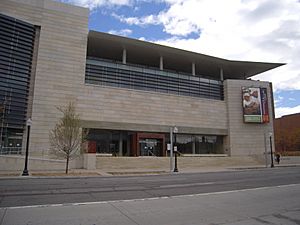
Arts and film
- List of museums in Colorado
- List of theaters in Colorado
- Music of Colorado
Several film productions have been shot on location in Colorado, especially prominent Westerns like True Grit, The Searchers, City Slickers, Butch Cassidy and the Sundance Kid, and My Life With the Walter Boys. Several historic military forts, railways with trains still operating, and mining ghost towns have been used and transformed for historical accuracy in well-known films. There are also several scenic highways and mountain passes that helped to feature the open road in films such as Vanishing Point, Bingo and Starman. Some Colorado landmarks have been featured in films, such as The Stanley Hotel in Dumb and Dumber and The Shining and the Sculptured House in Sleeper. In 2015, Furious 7 was to film driving sequences on Pikes Peak Highway in Colorado. The TV adult-animated series South Park takes place in central Colorado in the titular town. Additionally, The TV series Good Luck Charlie was set, but not filmed, in Denver, Colorado. The Colorado Office of Film and Television has noted that more than 400 films have been shot in Colorado.
There are also several established film festivals in Colorado, including Aspen Shortsfest, Boulder International Film Festival, Castle Rock Film Festival, Denver Film Festival, Festivus Film Festival, Mile High Horror Film Festival, Moondance International Film Festival, Mountainfilm in Telluride, Rocky Mountain Women's Film Festival, and Telluride Film Festival.
Many notable writers have lived or spent extended periods in Colorado. Beat Generation writers Jack Kerouac and Neal Cassady lived in and around Denver for several years each. Irish playwright Oscar Wilde visited Colorado on his tour of the United States in 1882, writing in his 1906 Impressions of America that Leadville was "the richest city in the world. It has also got the reputation of being the roughest, and every man carries a revolver."
Cuisine
Colorado is known for its Southwest and Rocky Mountain cuisine. Mexican restaurants are prominent throughout the state.
Boulder, Colorado was named America's Foodiest Town 2010 by Bon Appétit. Boulder, and Colorado in general, is home to a number of national food and beverage companies, top-tier restaurants and farmers' markets. Boulder, Colorado also has more Master Sommeliers per capita than any other city, including San Francisco and New York.
The Food & Wine Classic is held annually each June in Aspen, Colorado. Aspen also has a reputation as the culinary capital of the Rocky Mountain region.
Denver is known for steak, but now has a diverse culinary scene with many top-tier restaurants.
Wine and beer
Colorado wines include award-winning varietals that have attracted favorable notice from outside the state. With wines made from traditional Vitis vinifera grapes along with wines made from cherries, peaches, plums, and honey, Colorado wines have won top national and international awards for their quality. Colorado's grape growing regions contain the highest elevation vineyards in the United States, with most viticulture in the state practiced between 4,000 and 7,000 feet (1,219 and 2,134 m) above sea level. The mountain climate ensures warm summer days and cool nights. Colorado is home to two designated American Viticultural Areas of the Grand Valley AVA and the West Elks AVA, where most of the vineyards in the state are located. However, an increasing number of wineries are located along the Front Range. In 2018, Wine Enthusiast Magazine named Colorado's Grand Valley AVA in Mesa County, Colorado, as one of the Top Ten wine travel destinations in the world.
Colorado is home to many nationally praised microbreweries, including New Belgium Brewing Company, Odell Brewing Company, Great Divide Brewing Company, and Bristol Brewing Company. The area of northern Colorado near and between the cities of Denver, Boulder, and Fort Collins is known as the "Napa Valley of Beer" due to its high density of craft breweries.
Transportation
Colorado's primary mode of transportation (in terms of passengers) is its highway system. Interstate 25 (I-25) is the primary north–south highway in the state, connecting Pueblo, Colorado Springs, Denver, and Fort Collins, and extending north to Wyoming and south to New Mexico. I-70 is the primary east–west corridor. It connects Grand Junction and the mountain communities with Denver and enters Utah and Kansas. The state is home to a network of US and Colorado highways that provide access to all principal areas of the state. Many smaller communities are connected to this network only via county roads.
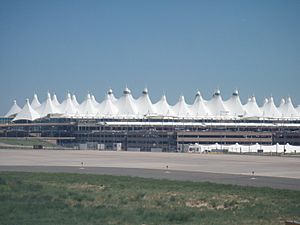
Denver International Airport (DIA) is the third-busiest domestic U.S. and international airport in the world by passenger traffic. DIA handles by far the largest volume of commercial air traffic in Colorado and is the busiest U.S. hub airport between Chicago and the Pacific coast, making Denver the most important airport for connecting passenger traffic in the western United States.
Public transportation bus services are offered both intra-city and inter-city—including the Denver metro area's RTD services. The Regional Transportation District (RTD) operates the popular RTD Bus & Rail transit system in the Denver Metropolitan Area. As of January 2013[update] the RTD rail system had 170 light-rail vehicles, serving 47 miles (76 km) of track. In addition to local public transit, intercity bus service is provided by Burlington Trailways, Bustang, Express Arrow, and Greyhound Lines.
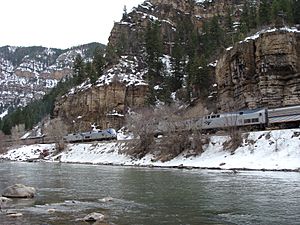
Amtrak operates two passenger rail lines in Colorado, the California Zephyr and Southwest Chief. Colorado's contribution to world railroad history was forged principally by the Denver and Rio Grande Western Railroad which began in 1870 and wrote the book on mountain railroading. In 1988 the "Rio Grande" was acquired, but was merged into, the Southern Pacific Railroad by their joint owner Philip Anschutz. On September 11, 1996, Anschutz sold the combined company to the Union Pacific Railroad, creating the largest railroad network in the United States. The Anschutz sale was partly in response to the earlier merger of Burlington Northern and Santa Fe which formed the large Burlington Northern and Santa Fe Railway (BNSF), Union Pacific's principal competitor in western U.S. railroading. Both Union Pacific and BNSF have extensive freight operations in Colorado.
Colorado's freight railroad network consists of 2,688 miles of Class I trackage. It is integral to the U.S. economy, being a critical artery for the movement of energy, agriculture, mining, and industrial commodities as well as general freight and manufactured products between the East and Midwest and the Pacific coast states.
In August 2014, Colorado began to issue driver licenses to aliens not lawfully in the United States who lived in Colorado. In September 2014, KCNC reported that 524 non-citizens were issued Colorado driver licenses that are normally issued to U.S. citizens living in Colorado.
Education
The first institution of higher education in the Colorado Territory was the Colorado Seminary, opened on November 16, 1864, by the Methodist Episcopal Church. The seminary closed in 1867 but reopened in 1880 as the University of Denver. In 1870, the Bishop George Maxwell Randall of the Episcopal Church's Missionary District of Colorado and Parts Adjacent opened the first of what become the Colorado University Schools which would include the Territorial School of Mines opened in 1873 and sold to the Colorado Territory in 1874. These schools were initially run by the Episcopal Church. An 1861 territorial act called for the creation of a public university in Boulder, though it would not be until 1876 that the University of Colorado was founded. The 1876 act also renamed Territorial School of Mines as the Colorado School of Mines. An 1870 territorial act created the Agricultural College of Colorado which opened in 1879. The college was renamed the Colorado State College of Agriculture and Mechanic Arts in 1935, and became Colorado State University in 1957.
The first Catholic college in Colorado was the Jesuit Sacred Heart College, which was founded in New Mexico in 1877, moved to Morrison in 1884, and to Denver in 1887. The college was renamed Regis College in 1921 and Regis University in 1991. On April 1, 1924, armed students patrolled the campus after a burning cross was found, the climax of tensions between Regis College and the locally-powerful Ku Klux Klan.
Following a 1950 assessment by the Service Academy Board, it was determined that there was a need to supplement the U.S. Military and Naval Academies with a third school that would provide commissioned officers for the newly independent Air Force. On April 1, 1954, President Dwight Eisenhower signed a law that moved for the creation of a U.S. Air Force Academy. Later that year, Colorado Springs was selected to host the new institution. From its establishment in 1955, until the construction of appropriate facilities in Colorado Springs was completed and opened in 1958, the Air Force Academy operated out of Lowry Air Force Base in Denver. With the opening of the Colorado Springs facility, the cadets moved to the new campus, though not in the full-kit march that some urban and campus legends suggest. The first class of Space Force officers from the Air Force Academy commissioned on April 18, 2020.
Indigenous People
The two Native American reservations remaining in Colorado are the Southern Ute Indian Reservation (1873; Ute dialect: Kapuuta-wa Moghwachi Núuchi-u) and Ute Mountain Ute Indian Reservation (1940; Ute dialect: Wʉgama Núuchi).
The two abolished Indian reservations in Colorado were the Cheyenne and Arapaho Indian Reservation (1851–1870) and Ute Indian Reservation (1855–1873).
Military installations
The major military installations in Colorado include:
- Buckley Space Force Base (1938–)
- Air Reserve Personnel Center (1953–)
- Fort Carson (U.S. Army 1942–)
- Piñon Canyon Maneuver Site (1983–)
- Peterson Space Force Base (1942–)
- Cheyenne Mountain Space Force Station (1961–)
- Pueblo Chemical Depot (U.S. Army 1942–)
- Schriever Space Force Base (1983–)
- United States Air Force Academy (1954–)
Former military posts in Colorado include:
- Spanish Fort (Spanish Army 1819–1821)
- Fort Massachusetts (U.S. Army 1852–1858)
- Fort Garland (U.S. Army 1858–1883)
- Camp Collins (U.S. Army 1862–1870)
- Fort Logan (U.S. Army 1887–1946)
- Colorado National Guard Armory (1913–1933)
- Fitzsimons Army Hospital (U.S. Army 1918–1999)
- Denver Medical Depot (U.S. Army 1925–1949)
- Lowry Air Force Base (1938–1994)
- Pueblo Army Air Base (1941–1948)
- Rocky Mountain Arsenal (U.S. Army 1942–1992)
- Camp Hale (U.S. Army 1942–1945)
- La Junta Army Air Field (1942–1946)
- Leadville Army Air Field (1943–1944)
Protected areas
Colorado is home to 4 national parks, 9 national monuments, 3 national historic sites, 2 national recreation areas, 4 national historic trails, 1 national scenic trail, 11 national forests, 2 national grasslands, 44 national wildernesses, 3 national conservation areas, 8 national wildlife refuges, 3 national heritage areas, 26 national historic landmarks, 16 national natural landmarks, more than 1,500 National Register of Historic Places, 1 wild and scenic river, 42 state parks, 307 state wildlife areas, 93 state natural areas, 28 national recreation trails, 6 regional trails, and numerous other scenic, historic, and recreational areas.
Sports
Colorado has five major professional sports leagues, all based in the Denver metropolitan area. Colorado is the least populous state with a franchise in each of the major professional sports leagues.
The Colorado Springs Snow Sox professional baseball team is based in Colorado Springs. The team is a member of the Pecos League, an independent baseball league which is not affiliated with Major or Minor League Baseball.
The Pikes Peak International Hill Climb is a major hill climbing motor race held on the Pikes Peak Highway.
The Cherry Hills Country Club has hosted several professional golf tournaments, including the U.S. Open, U.S. Senior Open, U.S. Women's Open, PGA Championship and BMW Championship.
Professional sports teams
| Team | Home | First game | Sport | League |
|---|---|---|---|---|
| Colorado Avalanche | Denver | October 6, 1995 | Ice hockey | National Hockey League |
| Colorado Eagles | Loveland | October 17, 2003 | Ice hockey | American Hockey League |
| Colorado Mammoth | Denver | January 3, 2003 | Lacrosse | National Lacrosse League |
| Colorado Rapids | Commerce City | April 13, 1996 | Soccer | Major League Soccer |
| Colorado Rapids 2 | Denver | March 27, 2022 | Soccer | MLS Next Pro |
| Colorado Rockies | Denver | April 5, 1993 | Baseball | Major League Baseball |
| Colorado Springs Switchbacks FC | Colorado Springs | March 28, 2015 | Soccer | USL Championship |
| Denver Barbarians | Denver | Spring 1967 | Rugby union | Pacific Rugby Premiership |
| Denver Broncos | Denver | September 9, 1960 | American football | National Football League |
| Denver Nuggets | Denver | September 27, 1967 | Basketball | National Basketball Association |
| Glendale Raptors | Glendale | Fall 2006 | Rugby union | Major League Rugby |
| Grand Junction Rockies | Grand Junction | June 18, 2012 | Baseball | Pioneer League |
| Northern Colorado Hailstorm FC | Windsor | April 6, 2022 | Soccer | USL League One |
| Northern Colorado Owlz | Windsor | May 25, 2022 | Baseball | Pioneer League |
| Rocky Mountain Vibes | Colorado Springs | June 2019 | Baseball | Pioneer League |
College athletics
The following universities and colleges participate in the National Collegiate Athletic Association Division I. The most popular college sports program is the University of Colorado Buffaloes, who used to play in the Big-12 but now play in the Pac-12. They have won the 1957 and 1991 Orange Bowl, 1995 Fiesta Bowl, and 1996 Cotton Bowl Classic.
| Team | School | City | Conference |
|---|---|---|---|
| Air Force Falcons | United States Air Force Academy | Colorado Springs | Mountain West |
| Colorado Buffaloes | University of Colorado Boulder | Boulder | Pac-12 |
| Colorado State Rams | Colorado State University | Fort Collins | Mountain West |
| Denver Pioneers | University of Denver | Denver | NCHC / Summit |
| Northern Colorado Bears | University of Northern Colorado | Greeley | Big Sky |
| Colorado College Tigers | Colorado College | Colorado Springs | NCHC / Mountain West |
See also
 In Spanish: Colorado para niños
In Spanish: Colorado para niños



